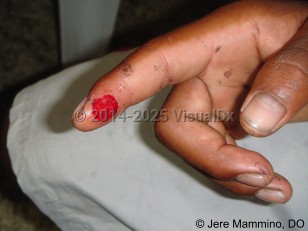The most common scenario for piranha bites is a single bite by a single fish of a person bathing or swimming in an area of water formed by the damming of a river, or a distracted amateur or professional fisherman. The great majority of bites of piranhas are inflicted by male fish protecting the eggs, which are commonly deposited in the aquatic vegetation near the edges of the water pools.
Still more rarely, a patient may present with a bite injury from a pet piranha.
The bites are circular in shape, with tearing of the affected tissue.
Piranhas can be found in South American freshwaters from the Orinoco River Basin in Venezuela to the Paraná River in Argentina. Piranhas of the genus Serrasalmus can be found in all regions of Brazil.
- The black piranha, Serrasalmus rhombeus, is an aggressive species and can reach up to 38 cm in length. It is found throughout the Amazon (although not in shoals) and remains in the river channels.
- The most common species in the midwest and southeast regions of Brazil are Serrasalmus maculatus, Serrasalmus marginatus, and Serrasalmus spilopleura ("piranha catirina").



